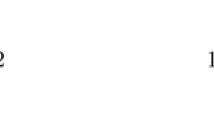Abstract
This paper introduces a new type of edge-coloring of multigraphs, called anfg-coloring, in which each color appears at each vertexv no more thanf(v) times and at each set of multiple edges joining verticesv andw no more thang(vw) times. The minimum number of colors needed tofg-color a multigraphG is called thefg-chromatic index ofG. Various upper bounds are given on thefg-chromatic index. One of them is a generalization of Vizing's bound for the ordinary chromatic index. Our proof is constructive, and immediately yields a polynomial-time algorithm tofg-color a given multigraph using colors no more than twice thefg-chromatic index.
Similar content being viewed by others
References
A. V. Aho, J. E. Hopcroft andJ. D. Ullman,The Design and Analysis of Computer Algorithms, Addison-Wesley, Reading, Mass.,1974.
E. G.Coffman, Jr., M. R.Garey, D. S.Johnson and A. S.LaPaugh, Scheduling file transfers,SIAM J. on Comput.,14, 3 (85), 744–780.
S. Fiorini andR. J. Wilson,Edge-Colouring of Graphs, Pitman, London,1977.
M. R. Garey andD. S. Johnson,Computers and Intractability; A Guide to the Theory of NP-Completeness, W. H. Freeman, New York,1979.
M. K.Goldberg, Edge-colorings of multigraphs: recoloring techniques,J. Graph Theory,8, 1 (84), 122–136.
S. L. Hakimi, Further results on a generalization of edge-coloring, inGraph Theory with Applications to Algorithms and Computer Science (Y. Alavi et al., Eds.), 371–389, John Wiley and Sons, New York,1985.
S. L.Hakimi and O.Kariv, On a generalization of edge-coloring in graphs,J. Graph Theory,10 (86), 139–154.
A. J. W. Hilton andD. de Werra, Sufficient conditions for balanced and for equitable edge-colorings of graphs, O. R. Working, paper 82/3.Dept. of Math., Ecole Polytechniques Federale de Lausanne, Switzerland,1982.
D. S.Hochbaum, T.Nishizeki and D. B.Shmoys, A better than “best possible” algorithm to edge color multigraphs,Journal of Algorithms,7, 1 (86), 79–104.
I. J.Holyer, The NP-completeness of edge-colourings,SIAM J. Comput.,10 (80), 718–720.
H.Krawczyk and M.Kubale, An approximation algorithm for diagnostic test scheduling in multicomputer systems,IEEE Trans. Comput., C-34,9 (85), 869–872.
S.Nakano, T.Nishizeki and N.Saito, On thef-coloring of multigraphs,IEEE Trans. Ciccuits and Systems,35, 3 (88), 345–353.
T. Nishizeki andK. Kashiwagi, An upper bound on the chromatic index of multigraphs, inGraph Theory with Applications to Algorithms and Computer Science (Y. Alavi et al., Eds.), 595–604, John Wiley and Sons, New York,1985.
C. E.Shannon, A theorem on coloring the lines of a network,J. Math. Phys.,28 (49), 148–151.
V. G.Vizing, On an estimate of the chromatic class of ap-graph,Discret Analiz.,3 (64), 25–30.
V. G.Vizing, The chromatic class of a multigraph,Kibernetica (Kief),3 (65), 29–39;Cybernetics,3 (65), 32–41.
D. de Werra, A few remarks on chromatic scheduling, inCombinatorial Programming: Methods and Applications (B. Roy, Ed.), D. Reidel, Dordrecht-Holland, 337–342,1975.
D.de Werra, Some results in chromatic scheduling,Zeitschrift fur Oper. Res.,18 (74), 167–175.
Author information
Authors and Affiliations
Rights and permissions
About this article
Cite this article
Nakano, S., Nishizeki, T. & Saito, N. On thefg-coloring of graphs. Combinatorica 10, 67–80 (1990). https://doi.org/10.1007/BF02122697
Received:
Revised:
Issue Date:
DOI: https://doi.org/10.1007/BF02122697




